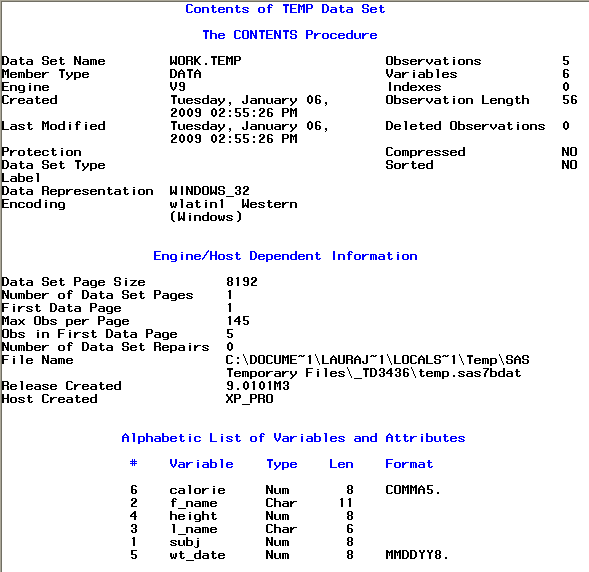

- HOW TO WRITE SAS PROGRAM WITH PAGENO AND OBS HOW TO
- HOW TO WRITE SAS PROGRAM WITH PAGENO AND OBS CRACK
What is the difference between '+' operator and SUM function? It can also be used to write output without creating a dataset.The idea of "null" here is that we have a data step that actually doesn't create a data set.ġ3. The DATA _NULL_ is mainly used to create macro variables. PDV is created followed by the creation of input buffer.SAS builds dataset in the PDV area of memory. SAS creates a dataset one observation at a time.Input buffer is created at the time of compilation, for holding a record from external file. When it is required to use newly created variables, useIF statement as it doesn't require variables to exist in the READIN data set.Multiple IF statements can be used to execute multiple conditional statements.WHERE statement can not be used when reading data using INPUT statement whereas IF statement can be used.WHERE statement can be used to search for all similar character values that sound alike while IF statement cannot be used.It tells SAS not to read all observations from the data set WHERE statement is more efficient than IF statement.WHERE can be used as a data set option while IF cannot be used as a data set option.WHERE statement can be used in procedures to subset data while IF statement cannot be used in procedures.Differences between WHERE and IF statement? For detailed explanation, see this tutorial - SAS : Where Vs IF In other words,The MEAN function will sum across the row and a procedure will SUM down a column.ġ0. The average that is calculated using PROC MEANS is the sum of all of the values of a variable divided by the number of observations in the variable. The MEAN function is an average of the value of several variables in one observation. Name and describe functions that you have used for data cleaning? PROC MEANS produce the “default” statistics of N, MIN, MAX, MEAN and STD DEV.Ĩ. proc print data = readin (firstobs=5 obs=10) ħ.What are the default statistics that PROC MEANS produce? The FIRSTOBS= and OBS=data set options would tell SAS to print observations 5 through 10 from the data set READIN.
HOW TO WRITE SAS PROGRAM WITH PAGENO AND OBS HOW TO
How to print observations 5 through 10 from a data set? The main difference between DROP/ KEEP statement and DROP=/ KEEP=data set option is that you can not use DROP/KEEP statement in procedures.Ħ. The KEEP statement specifies the names of the variables that you want to retain from the data set. The DROP statement specifies the names of the variables that you want to remove from the data set. DROP, KEEP Statements and Data set Options

How to include or exclude specific variables in a data set? The double trailing sign SAS rather than advancing to a new record, hold the current input record for the execution of the next INPUT statement. to read a single field in each record of raw data and to assign values to the variable ID. This DATA step uses the numeric informat 4. The following is an example of an external file that contains data: Truncover - It assigns the raw data value to the variable even if the value is shorter than the length that is expected by the INPUT statement. Instead, MISSOVER setsvariables to missing. Missover -When the MISSOVER option is used on the INFILE statement, the INPUT statement does not jump to the next line when reading a short line. Difference between Missover and Truncover tells SAS to read the number121713as the date December 17, 2013.įormat - To tell SAS how to print the variables.ģ. Informat - To tell SAS that a number should be read in a particular format.įor example: the informat mmddyy6.

Informats read the data while Formats write the data. In the example shown above, ID and SEX are numeric variables and Name a character variable.Ģ. Note : The variable name, followed by $ (dollar sign), idenfities the variable type as character. The INFILE statement is used to identify an external file while the INPUT statment is used to describe your variables. It includes questions ranging from simple theoretical concepts to tricky interview questions which are generally asked in freshers and experienced SAS programmers' interview. It covers basic, intermediate and advanced concepts of SAS which outlines topics on reading data into SAS, data manipulation, reporting, SQL queries and SAS Macros.
HOW TO WRITE SAS PROGRAM WITH PAGENO AND OBS CRACK
This article includes most frequently asked SAS interview questions which would help you to crack SAS Interview with confidence.


 0 kommentar(er)
0 kommentar(er)
